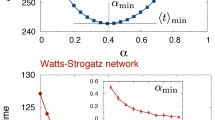Abstract
In this paper, we consider the problem of finding minimal cost linkages in graphs. Wediscuss how this problem arises in practice and, in particular, its relevance to the military.Given a graph G with an associated cost function and a multiset of vertex pairs, weaddress the problem of finding a linkage of minimal cost. From this optimisation problem,we are able to define the decision problems Min‐Sum Non‐Intersecting Paths (MSNP) andMin‐Max Non‐Intersecting Paths (MMNP), and prove their NP‐completeness. We also showthat for fixed k >= 2, where k denotes the number of terminal pairs, MMNP remains NP‐complete.We also define restricted versions of the problems, MMNP(r) and MSNP(r), where link-agesmay only be defined over the r cheapest paths between each vertex pair. For fixedk >= 3, we show the restricted problems remain NP‐complete and discuss the limitations ofthe restriction.We include a case study which demonstrates the advantages of using heuristic methods,such as genetic algorithms and simulated annealing, to find solutions to the optimisationproblem MSNP(r).
Similar content being viewed by others
References
I. Abos, On some problems of computer aided layout design, in: Proceedings of the 6th Colloquium on Microwave Communication, Vol. 1, Budapest, 1978.
P. Chardaire, G.P. McKeown and V.J. Rayward-Smith, Convoy movement problems: Some models and solution methods based on linear and integer programming approaches, Final Report, DERA, 1997.
S.A. Cook, The complexity of theorem-proving procedures, in: Proceedings of the 3rd Annual ACM Symposium on the Theory of Computing, New York, 1971, pp. 151-158.
V. Cérny, A thermodynamical approach to the travelling salesman problem: An efficient simulation algorithm, Journal of Optimisation Theory and Applications 45(1985)41-55.
D. de Werra and A. Hertz, Tabu search techniques: A tutorial and an application to neural networks, OR Spektrum 11(1989)131-141.
S. Fortune, J.E. Hopcroft and J. Wylie, The directed subgraph homeomorphism problem, Journal of Theoretical Computer Science 10(1980)111-121.
M.R. Garey and D.S. Johnson, Computers and Intractability: A Guide to the Theory of NP-Completeness, W.H. Freeman, 1979.
F. Glover, E. Taillard and D. de Werra, A user's guide to tabu search, Annals of OR 41(1993)3-28.
D.E. Goldberg, Genetic Algorithms in Search, Optimization and Machine Learning, Addison-Wesley, 1989.
F. Harary, Graph Theory, Addison-Wesley, 1969.
J.H. Holland, Adaptation in Natural and Artificial Systems, The University of Michigan Press, Ann Arbor, 1975.
D.S. Johnson, The NP-completeness column: An ongoing guide, Journal of Algorithms 8(1987)285-303.
R.M. Karp, Reducibility among combinatorial problems, in: Complexity of Computer Computations, Plenem Press, New York, 1972, pp. 85-103.
R.M. Karp, On the complecity of combinatorial problems, Networks 5(1975)45-68.
S. Kirkpatrick, C.D. Gellat and M.P. Vecchi, Optimisation by simulated annealing, Science 220 (1983)671-680.
A. LaPaugh, Algorithms for integrated circuit layout: An analytic approach, Ph.D. Thesis, M.I.T. Lab. Computer Science, Cambridge, MA, 1980.
Y.N. Lee, Sequential and parallel solutions of the convoy movement problem using branch-and-bound and heuristic hybrid techniques, Ph.D. Thesis, School of Information Systems, University of East Anglia, Norwich NR4 7TJ, UK, 1995.
Y.N. Lee, G.P. McKeown and V.J. Rayward-Smith, Convoy movement problem with initial delays, in: Proceedings of ADT95 Conference, UNICOM Conference, Brunel University, 1995, pp. 353-376.
Y.N. Lee, G.P. McKeown and V.J. Rayward-Smith, The convoy movement problem, Computing Science Technical Report SYS-C94-01, University of East Anglia, Norwich, UK, 1994.
Y.N. Lee, G.P. McKeown and V.J. Rayward-Smith, Solving the convoy movement problem using branch-and-bound on a network of transputers, in: Transputer Applications and Systems '94, IOS Press. 1994, pp. 786-796.
J.-T. Li and M. Marek-Sadowsijka, Global routing for gate array, IEEE Transactions on Computer-Aided Design of Integrated Circuits and Systems 3(1984)298-307.
M. Lundy and A. Mees, Convergence of an annealing algorithm, Mathematical Programming 34 (1986)111-124.
J.F. Lynch, The equivalence of theorem proving and the interconnection problem, ACM SIGDA Newsletter 5(3)(1975.
J.W. Mann, X-GAmeter v2.0: User manual, School of Information Systems Technical Report, University of East Anglia, Norwich NR4 7TJ, UK, 1995.
J.W. Mann, X-SAmson v1.5: User manual, School of Information Systems Technical Report, University of East Anglia, Norwich NR4 7TJ, UK, 1995.
N. Metropolis, A.W. Rosenbluth, M.N. Rosenbluth, A.H. Teller and E. Teller, Equation of state calculation by fast computing machine, Journal of Chemical Physics 21(1953)1087-1091.
C. Papadimitrious, Computational Complexity, Addison-Wesley, 1994.
C.R. Reeves (ed.), Modern Heuristic Techniques for Combinatorial Problems, Advanced Topics in Computer Science, Blackwell Scientific, 1993.
N. Robertson and P.D. Seymour, Graph minors XIII: The disjoint paths problem, Journal of Combinatorial Theory Series B 63(1995)65-110.
S. Sahni and A. Bhatt, The complexity of design automation problems, in: Proceedings of the 17th Design Automation Conference, New York, 1980, pp. 402-411.
P.D. Seymour, Disjoint paths in graphs, Discrete Mathematics 29(1980)293-309.
Y. Shiloach, A polynomial solution to the undirected two paths problem, Journal of the Association of Computing Machines 27(1980)445-456.
H. Suzuki, A. Ishiguro and T. Nishizeki, Edge-disjoint paths in a grid bounded by two nested rectangles, Discrete Applied Mathematics 27(1990)157-178.
T. Szymanski, Dogleg channel routing is NP-complete, IEEE Transations on Computer-Aided Design of Integrated Circuits and Systems 4(1985)31-40.
C. Thomassen, 2-linked graphs, European Journal of Combinatorics 1(1980)371-378.
D. Whitley, A genetic algorithm tutorial, Statistics and Computing 4(1994)65-85.
J.Y. Yen, Finding the k shortest loopless paths in a network, Management Science 17(1971)712-716.
Rights and permissions
About this article
Cite this article
Harrison, S., Rayward‐Smith, V. Minimal cost linkages in graphs. Annals of Operations Research 86, 295–319 (1999). https://doi.org/10.1023/A:1018963020368
Issue Date:
DOI: https://doi.org/10.1023/A:1018963020368




